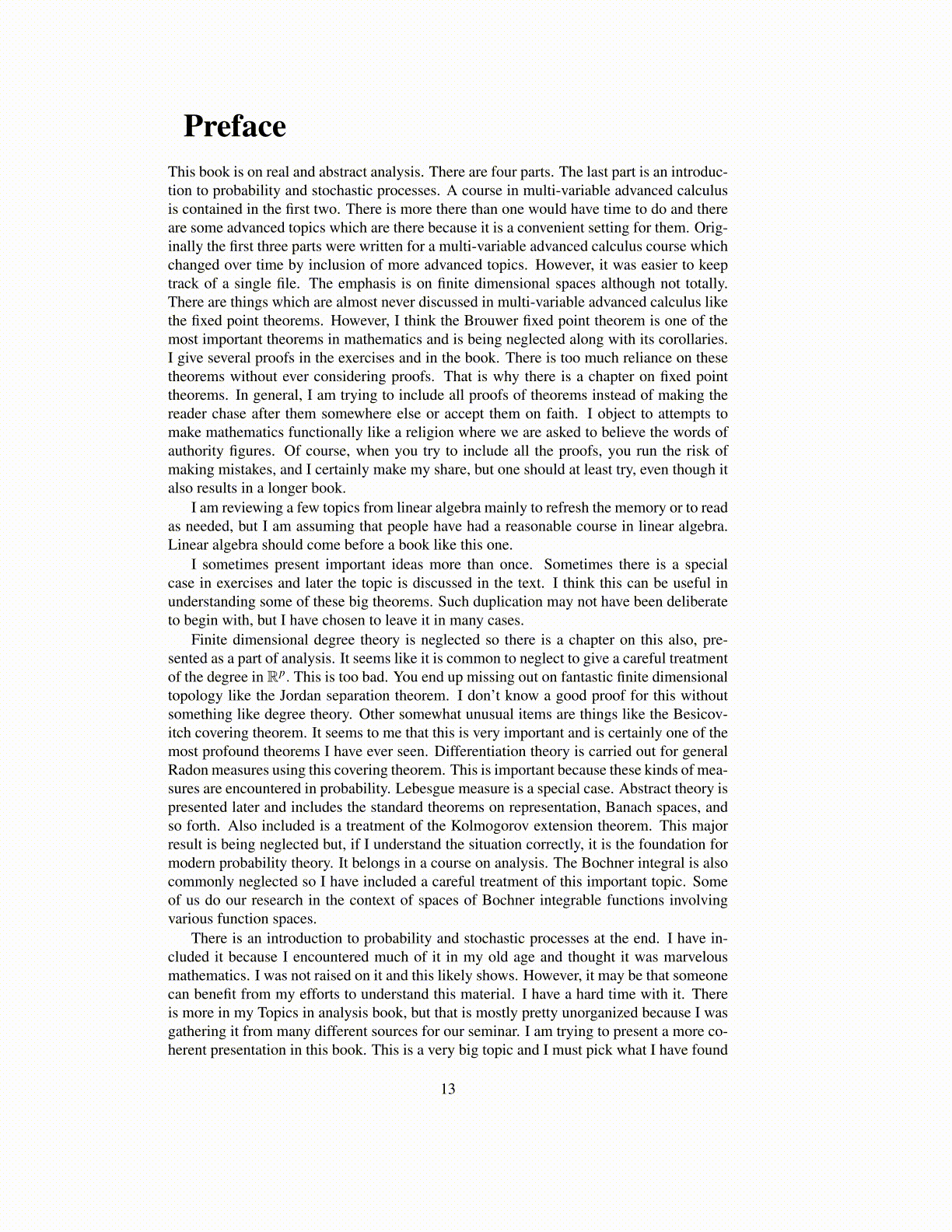
PrefaceThis book is on real and abstract analysis. There are four parts. The last part is an introduc-tion to probability and stochastic processes. A course in multi-variable advanced calculusis contained in the first two. There is more there than one would have time to do and thereare some advanced topics which are there because it is a convenient setting for them. Orig-inally the first three parts were written for a multi-variable advanced calculus course whichchanged over time by inclusion of more advanced topics. However, it was easier to keeptrack of a single file. The emphasis is on finite dimensional spaces although not totally.There are things which are almost never discussed in multi-variable advanced calculus likethe fixed point theorems. However, I think the Brouwer fixed point theorem is one of themost important theorems in mathematics and is being neglected along with its corollaries.I give several proofs in the exercises and in the book. There is too much reliance on thesetheorems without ever considering proofs. That is why there is a chapter on fixed pointtheorems. In general, I am trying to include all proofs of theorems instead of making thereader chase after them somewhere else or accept them on faith. I object to attempts tomake mathematics functionally like a religion where we are asked to believe the words ofauthority figures. Of course, when you try to include all the proofs, you run the risk ofmaking mistakes, and I certainly make my share, but one should at least try, even though italso results in a longer book.
I am reviewing a few topics from linear algebra mainly to refresh the memory or to readas needed, but I am assuming that people have had a reasonable course in linear algebra.Linear algebra should come before a book like this one.
I sometimes present important ideas more than once. Sometimes there is a specialcase in exercises and later the topic is discussed in the text. I think this can be useful inunderstanding some of these big theorems. Such duplication may not have been deliberateto begin with, but I have chosen to leave it in many cases.
Finite dimensional degree theory is neglected so there is a chapter on this also, pre-sented as a part of analysis. It seems like it is common to neglect to give a careful treatmentof the degree in Rp. This is too bad. You end up missing out on fantastic finite dimensionaltopology like the Jordan separation theorem. I don’t know a good proof for this withoutsomething like degree theory. Other somewhat unusual items are things like the Besicov-itch covering theorem. It seems to me that this is very important and is certainly one of themost profound theorems I have ever seen. Differentiation theory is carried out for generalRadon measures using this covering theorem. This is important because these kinds of mea-sures are encountered in probability. Lebesgue measure is a special case. Abstract theory ispresented later and includes the standard theorems on representation, Banach spaces, andso forth. Also included is a treatment of the Kolmogorov extension theorem. This majorresult is being neglected but, if I understand the situation correctly, it is the foundation formodern probability theory. It belongs in a course on analysis. The Bochner integral is alsocommonly neglected so I have included a careful treatment of this important topic. Someof us do our research in the context of spaces of Bochner integrable functions involvingvarious function spaces.
There is an introduction to probability and stochastic processes at the end. I have in-cluded it because I encountered much of it in my old age and thought it was marvelousmathematics. I was not raised on it and this likely shows. However, it may be that someonecan benefit from my efforts to understand this material. I have a hard time with it. Thereis more in my Topics in analysis book, but that is mostly pretty unorganized because I wasgathering it from many different sources for our seminar. I am trying to present a more co-herent presentation in this book. This is a very big topic and I must pick what I have found
13